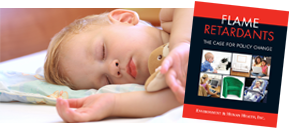Flame Retardants: The Case for Policy Change
Archived studies and news reports that expand the scope of Environment & Human Health, Inc.'s (EHHI) research reports about health and the environment.
Minnesota bans flame-retardant chemicals in household products
The law bans the manufacture and sale of mattresses, children's products, upholstered furniture and textiles that contain certain flame retardants. Firefighters lobbied for the bill's passage. Studies show firefighters have a 14% greater chance of dying from cancer than the general public. Click here for news story.
Workout clothing and yoga pants contain PFAs
Testing finds fluorine—an indicator of PFAS—in women’s sportswear from popular brands like Old Navy and Lululemon, according to a report in Environmental Health News. PFAs are "forever chemicals" such as halogenated flame retardants that contain bromine, chlorine, fluorine and iodine.
Mattress company Naturepedic makes certified organic mattresses
Naturepedic specializes in the design and manufacturing of independently certified organic mattresses for adults and children that promote natural and organic materials without chemical flame retardants. As part of Naturepedic's ongoing sustainability efforts, the company reported that it has joined the EPA Green Power Partnership, pledging to support renewable energy for its operations. Click here for news story.
Sen. Charles Schumer Proposes Ban On 10 Flame Retardants In Children's Products
Sen. Charles Schumer (D-NY) is proposing legislation to ban 10 flame retardants from upholstered furniture and children's products, saying the chemicals have been linked to developmental delays and cancer. A recent study by the Environmental Working Group and Duke University found children at particular risk from dust containing the toxins. Click here for news story.
News items are not independently verified by EHHI and inclusion on this site does not constitute an endorsement.
EHHI's Flame Retardants Report
In the 1970s, a flame-retardant called "Tris" was added to children's sleepwear. Tris was later found not only to be carcinogenic, but also capable of being absorbed through the skin. Tris was finally banned in children's sleepwear in 1977.
Unbelievably, however, Tris is still used in many other infant products, such as crib mattresses, changing tables, nap mats, and infant car seats. Flame-retardants are now ubiquitous in our environment.
Recent toxicological studies demonstrate that flame-retardants pose the greatest risk to the normal growth and development of fetuses, infants and children.
For further information about the health effects of exposures to flame retardants, download EHHI's report or click here to learn more.

